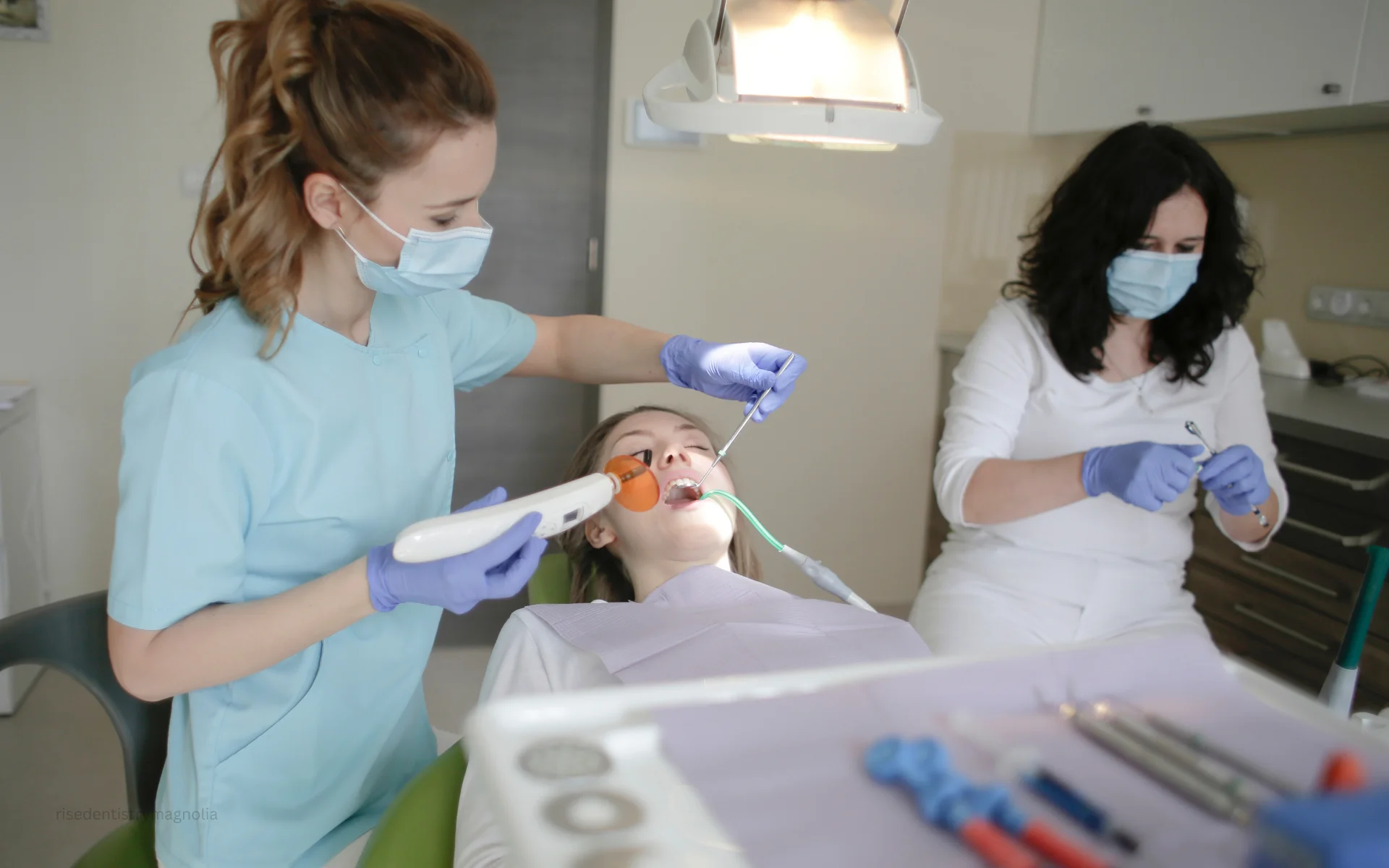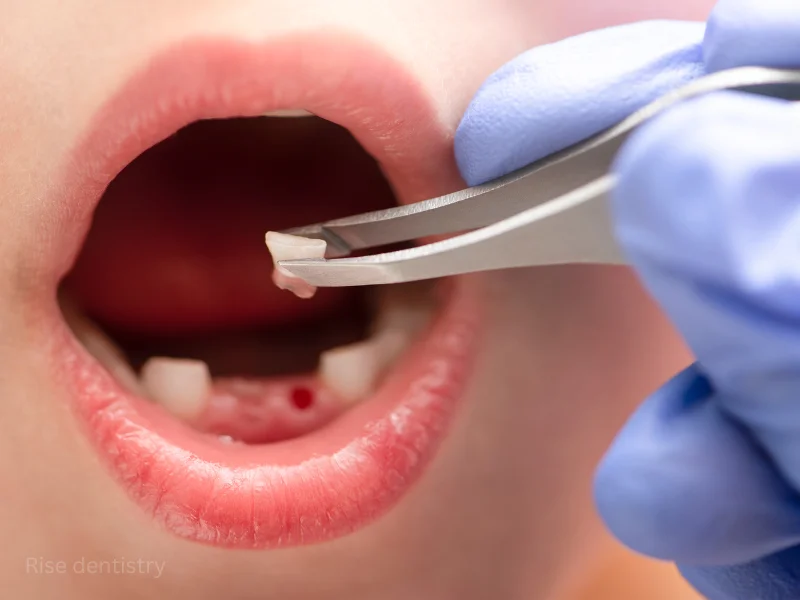
Tooth extractions are quick and safe, usually completed in minutes. Learn what to expect and ensure a smooth procedure—prepare for your appointment today!
If your dentist has recommended a tooth extraction, you might be wondering, how long does a tooth extraction take and what to expect during the process. The good news is that it’s a simple, safe, and routine treatment performed every day.
In some cases, removal is the only option when a tooth is too damaged or decayed for repair. The actual tooth extraction time can vary based on your situation. It depends on how severe the damage is, where the tooth is located, and your overall oral condition.
At Rise Dentistry, every procedure is carefully done under local anesthesia to keep you relaxed and pain-free. Our team ensures your comfort and focuses on protecting your oral health throughout the process.
This procedure is a safe, routine treatment designed to remove a damaged tooth with minimal discomfort. Dentists perform two types — simple and surgical extractions.
A simple extraction removes a visible tooth easily. A surgical dental extraction procedure is needed when the tooth is broken or lies beneath the gum tissue.
Your dentist applies local anesthesia to numb the tooth socket and surrounding area. Using precise instruments, they perform the tooth removal and clean the extraction site carefully.
If needed, stitches are placed to aid healing. Learn more about our Tooth Extraction services at Rise Dentistry, where every procedure ensures comfort and lasting oral health.
Not every dental procedure takes the same amount of time. Some are quick and simple, while others need more care and precision.
A broken tooth extraction often takes longer since the dentist must carefully remove small pieces. Extracting multiple teeth also adds time because each one needs individual attention.
In cases of infection or impaction, the process becomes more complex and may involve minor oral surgery. Deep-rooted or molar teeth usually take extra time as they require more effort to loosen and remove.
Here are a few main factors that affect extraction time:

Complexity of the tooth

Number of teeth being removed

Type of local anesthesia used

Patient’s comfort and response during the procedure
At Rise Dentistry, every case is handled with care to ensure a smooth and comfortable experience.
Knowing what to expect during your appointment can make the experience much easier. A typical extraction happens in a few simple steps.
1. Consultation: Your visit begins with a quick exam and X-rays. The dentist reviews your medical history and discusses treatment options.
2. Anesthesia: Local anesthesia is used to numb the area completely, ensuring a pain-free experience.
3. Removal: The tooth is gently loosened and removed. This stage usually takes 20 to 60 minutes, depending on complexity.
4. Cleaning and Care: The dentist cleans the area and explains how to care for your mouth afterward.
5. Recovery Guidance: You’ll receive clear instructions to support faster healing and maintain strong oral health.
At Rise Dentistry, comfort and care come first at every step.

It’s normal to feel mild pain after tooth extraction, especially within the first few days. The body begins its natural healing process right away, helping the area recover and close safely.
Soon after the procedure, a blood clot forms inside the socket to protect the bone and nerves. Avoid touching the area or rinsing forcefully, as it may dislodge the clot and delay healing. A disturbed clot can lead to dry socket, which causes extra discomfort.
Some swelling is also common. Placing an ice pack on your cheek for 15 minutes at a time reduces it. With gentle care and rest, most people heal quickly after oral surgery and feel normal again within a few days.

The healing stage of tooth extraction begins once the procedure ends. A blood clot forms over the area to protect the gum tissue and start recovery.
Mild swelling and soreness are normal. The clot remains in place while new tissue forms beneath it. This prevents irritation and supports steady healing.
For most people, recovery after teeth extraction takes about one week. Surgical cases may need a little more time to fully heal.
Stick to soft foods like yogurt and soup. Gently clean your mouth to avoid disturbing the area. With proper care, your gums recover quickly and feel normal again.
Proper tooth extraction aftercare helps your mouth heal quickly and comfortably. Follow these simple tips to care for your extraction site and maintain good oral health:

Drink plenty of water to stay hydrated.

Eat soft foods like yogurt, eggs, and mashed potatoes.

Rinse your mouth gently with salt water a day after the procedure.

Keep the extraction site clean without brushing directly over it.

Rest well and allow your body to heal naturally.

Schedule follow-up visits with our Family Dentistry team for ongoing care.

Don’t use a straw — it can dislodge the blood clot.

Skip smoking or vaping for at least two days to support proper healing.

Skip heavy exercise or lifting for two days.

Don’t touch or poke the extraction site.
These small steps support faster recovery after tooth removal and protect your long-term oral health.

Following the extraction, it’s normal to experience slight swelling and soreness. These signs usually fade within a few days as your gum tissue heals naturally.
However, contact your dentist if you experience severe pain, continuous bleeding, or signs of infection. Swelling that increases instead of improving, or pus around the extraction site, should also be checked right away.
If you notice fever, a foul taste, or unusual discharge in your mouth, don’t wait. Early care prevents complications and protects your oral health. At Rise Dentistry, we’re dedicated to safe, gentle treatments and quick healing after every visit.

Yes, a molar extraction usually takes more time because molars have larger roots and are harder to reach. Your dentist carefully removes them to avoid damaging nearby teeth and tissues.
Mild discomfort may last for two to three days. Most people feel better within a week as tooth extraction healing progresses.
You can eat soft foods a few hours after the procedure. Avoid crunchy or hot meals until the extraction tooth healing time improves.
The tooth extraction recovery time depends on the tooth’s position, root shape, and the patient’s overall health.
Before your visit, discuss medications with your dentist. Eat a light meal and plan rest afterward to support faster healing.

An extraction doesn’t have to be stressful when handled with care and precision. At Rise Dentistry, every procedure is performed gently to protect your comfort and oral health.
Our experienced team specializes in Family Dentistry, offering personalized care for patients of all ages. We focus on creating a calm, safe environment and ensuring smooth recovery after treatment.
Ready to take the next step? Schedule your consultation today and experience professional dental care that keeps your smile healthy and confident.

© 2023-2025 Rise Dentistry. All rights reserved.